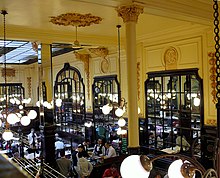

In France, a bouillon (French pronunciation: [bujɔ̃] ) is a traditional (late 19th or early 20th century), spacious restaurant that usually serves traditional French cuisine, in particular a bouillon, which has provided the name for this class of restaurants.
When invented, the concept was to serve good quality food quickly, at an affordable price. By repeating the same formula across multiple sites, the founder also effectively invented the chain restaurant; however, the wider idea had no influence (beyond other bouillons) and ultimately it was American chains which revived the idea in France.
Today, the buildings of some bouillons are listed historical monuments.
History
In 1838, a Dutch company began to sell bouillon in uniform outlets. These first "Bouillons Hollandais" did not survive, but in 1854 a French butcher, Adolphe-Baptiste Duval (1811-1870), revived the idea (and is typically erroneously credited with originating it).

He proposed a single dish of meat, and a bouillon (soup/stock) to the workers of the market halls. In 1900, nearly two hundred and fifty bouillons could be found in Paris. They became the first popular chain of restaurants. Some other more "upper-class" bouillons offered a reading room or some entertainment.
Meanwhile, Art Nouveau spread through Europe. The various World's Fairs in Paris 1878, 1889, and 1900, accelerated its influence, and restaurants followed the trend.
In 1896, Bouillon Chartier was opened by brothers Frédéric and Camille Chartier on Rue du Faubourg Montmartre.
In 1903, Bouillon Gandon-Duval opened in an old restaurant converted by the owner and architect, Edouard Fournier.
In 1904, another bouillon with luxurious Art Nouveau decoration was opened on Boulevard Saint-Germain. The architect was Jean-Marie Bouvier. Today, it houses Brasserie Vagenende, which is not a bouillon.
With Louis Trezel Edouard Chartier opened two further Bouillons Chartier in 1906: the Grand Bouillon Camille Chartier on Rue Racine and the Bouillon Edouard Chartier on Boulevard Montparnasse. These restaurants were created in the Art Nouveau style: carved wood and ceramics, with mirrors and painted glass details.
Nowadays, only a few authentic bouillons remain, such as the one of the Faubourg-Montmartre and in particular the one in Rue Racine, which has the most baroque style of Art Nouveau.
Until 1926, Camille Chartier remained the owner. After being called Bouillon Ollé and Joussot, it was Mme. Launois who kept the restaurant until 1956. The following purchaser sold the goodwill to the University of Paris, which opened a restaurant there for the staff of the Sorbonne from 1962 until 1993. The major part of the decoration survived but the restaurant did not benefit from the special care allotted to luxurious restaurants.
The complete renovation of Bouillon Racine took place in 1996, thanks to the Compagnons du Tour de France. It required artisans and experts who had the skills of techniques nearly lost. Bevelled mirrors, painted opalines, stained glass, carved woodworks, marble mosaics and gold-leaf lettering provide the public with the pleasure of an opulent space, as much by its beauty as its conviviality. It was subsequently classified as a historic building.
Since 2017, the Parisian bouillon has seen a resurgence. Bouillon Chartier Montparnasse, which had been lately functioning as a brasserie named Montparnasse 1900, reprised its original vocation (and name) in 2019. Two new bouillons have been launched by the Moussié brothers, Pierre and Guillaume: Bouillon Pigalle (opened in 2017 on Boulevard Clichy) and Bouillon République (opened in 2021 in the former home of the venerable brasserie, Chez Jenny).
Popular culture
- The novel A Killer at Sorbonne (French: Un tueur en Sorbonne) by René Reouven was inspired by the characters and customers at Bouillon Racine. In this context, the novelist recalls the assassination of Symon Petliura by Sholom Schwartzbard in 1926 which took place at the exit of Bouillon Camille Chartier (i.e. Bouillon Racine).
- In 1939, Fernandel sings of Chez Chartier in the song "Félicie aussi" by Albert Willemetz:
Afin d'séduire la petite chatte. Je l'emmenai dîner chez Chartier
Comme elle est fine et délicate. Elle prit un pied d'cochon grillé
(English: To seduce the little pussy-cat, I took her out to dine at Chartier's
As she is fine and considerate, she chose roast pig's trotter)
- In Les Beaux Quartiers by Louis Aragon, Chez Chartier is mentioned as the restaurant in which young Edmond Barbentane lunches regularly.
- The setting of the closing scene of La Chose publique by Mathieu Amalric is at Chez Chartier.
See also
Videos
- Chartier restaurant Paris (French)
Books
- Matthieu Flory/Clémentine Forissier: Restaurants, brasseries et bistrots parisiens. Editions Ereme, Paris 2007, pp. 82–85, ISBN 9782915337471
- Jean Colson/Marie-Christine Lauroa (Eds.): Dictionnaire des monuments de Paris. Editions Hervas, Paris 2003, ISBN 2-84334-001-2
References
- Jim Chevallier, A History of the Food of Paris: From Roast Mammoth to Steak Frites, 2018, ISBN 1442272821, pp. 96, 115
- Base Mérimée: Reference PA00088899 - Bouillon Chartier, 7 rue du Faubourg-Montmartre, Ministère français de la Culture. (in French)
- Base Mérimée: Reference PA00086515 – Chez Julien (formerly, a Bouillon Chartier), 16 rue du Faubourg-Saint-Denis, Ministère français de la Culture. (in French)
- Base Mérimée: Reference PA00088661 – Le Vagenende (formerly, a Bouillon Chartier), 142 boulevard Saint-Germain, Ministère français de la Culture. (in French)
- Base Mérimée: Reference PA00088667 – Bouillon Racine, 3 rue Racine, Ministère français de la Culture. (in French)
- Base Mérimée: Reference PA00088659 – Bistrot de la Gare (formerly, Restaurant Rougeot), 59 boulevard du Montparnasse, Ministère français de la Culture. (in French)
- uel="https://books.google.com/books?id=u-RTAAAAcAAJ&dq=%22musee%20industriel%22&hl=fr&pg=RA1-PA226#v=onepage&q&f=false /"
- url="https://gallica.bnf.fr/ark:/12148/bpt6k114789v/f81.image.r=%22bouillons%20hollandais%22">
- Paris Digest,
- Auvergnat,
- Paris ZigZag,
- La vengeance du Juif, L'Ouest-Éclair, 27 May 1926, p. 3
External links
- Restaurant Chartier
- Bouillon Racine
- Le Grand Colbert
- Restaurant le Court-Bouillon
- Au Bouillon Normand
- Bouillon Bilk
- Restaurant Le Vagenende